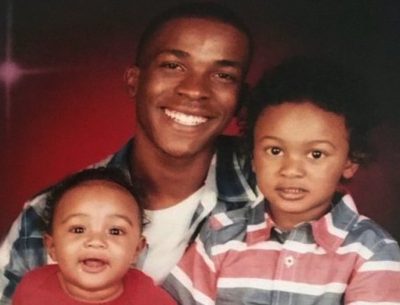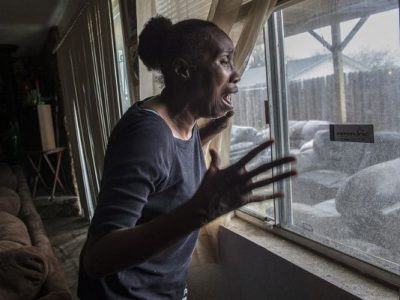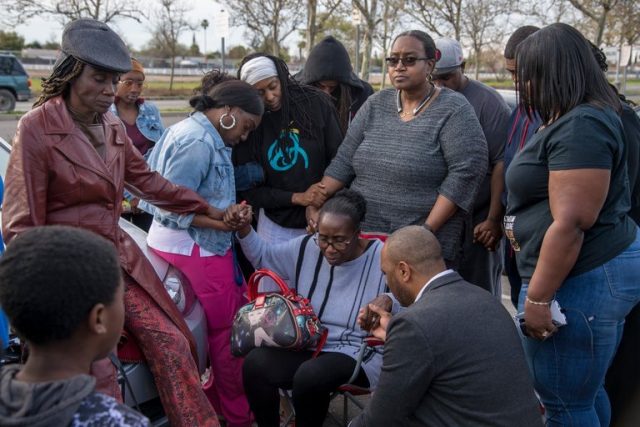FATHER OF TWO WAS ONLY HOLDING A CELLPHONE
Police fired 2o times in dark backyard

P.R. Lockhart
March 21, 2018.

Stephon Clark. 22, with his two young children.
SACRAMENTO, CA–Officers say they mistook Stephon Clark’s cellphone for a gun. Activists want more answers.
Police killings of unarmed black men helped fuel the rise of the Black Lives Matter Movement. Now a new tragedy — the shooting death of an unarmed black man in his own backyard — is raising new questions about how much things have changed, if at all.
On Sunday, 22-year-old Stephon Clark was shot in the backyard of the home he was staying in with his grandparents. Police officers were purportedly responding to reports of a man breaking car windows.
According to a press release issued by the Sacramento Police Department, a helicopter tracking a suspect directed the officers to Clark, who ran towards the house after being confronted by officers. The police department said Clark turned and began to “advance forward with his arms extended, and holding an object in his hands.”
The officers, who are said to have thought the object was a gun, then fired 20 rounds at Clark. It’s unclear how many of the shots hit Clark, but other facts aren’t in dispute, and they’re disturbing: After the shooting, officers waited several minutes for backup before moving to handcuff Clark and beginning medical treatment. And the only item he turned out to have been carrying was a cellphone.
The shooting has sparked public outcry both locally and nationally. And, nearly four years after the death of Michael Brown sparked the rise of Black Lives Matter and brought more attention to racial disparities in police shootings, the Clark case serves as a stark reminder that even as national attention has waned, unarmed Black men and women continue to experience deadly encounters with police.
There are a lot of questions and few answers about the Sacramento shooting

Clark’s grandmother Sequita Thompson recounts horror from the window behind the backyard where he was killed by police.
What happened immediately before Clark’s shooting remains unclear, and his family and community are demanding answers.
”He was at the wrong place at the wrong time in his own backyard?” Sequita Thompson, Clark’s grandmother, said to the Sacramento Bee on Tuesday. Thompson also said that though she heard the gunshots, she never heard the police ask Clark to drop what he was holding. Clark’s family also said that they were not immediately told that their relative was the man killed in their backyard.
At a city council meeting in Sacramento on Tuesday, local activists argued that the police department’s multiple statements on the shooting have only added to the confusion. “They put one story out that he may have been armed. They put out another that he had a ‘tool bar,’ whatever that is,” Tanya Faison, founder of the Sacramento chapter of Black Lives Matter, told reporters. “Then they put out that he had a wrench, and then they put out that he just had a cellphone. They need to get it together.”
The officers who shot Clark have each served in the Sacramento Police Department for less than five years, and were placed on paid leave while the investigation continues. Both officers were wearing body cameras. A local ordinance requires that footage from the cameras be released to the public within 30 days, and the department says that it plans to release video and audio from the helicopter in the near future.
Clark’s shooting is the latest in a troubling pattern
Clark’s death follows several high profile police shootings of black men in recent years. According to the Washington Post’s Fatal Force database, some 230 people have been shot and killed by police in 2018. 38 of those people were identified as Black in news reports.
Research has shown that there are significant racial disparities in police use of force. While these disparities are most commonly attributed to issues like implicit bias and systemic racism, recent research has also noted that specific factors like high levels of housing segregation and economic inequality also play a role in where police shootings occur and who they affect.
“It’s not just about how individuals interact, but how society is structured,” Michael Siegel, the author of a recent study examining the relationship between housing segregation and structural inequality to police violence, told the Intercept earlier this month.
At this point, it is unclear what the results of the police investigation will be, or if the officers will face charges for the shooting. But when police officers shoot civilians, it is rare that these cases lead to prosecution. As Vox’s German Lopez has noted, police are given wide latitude to use force and only have to reasonably perceive a threat at the time of the shooting for their actions to be legally just.

Grandmother Sequita Thompson (seated) leads Clark’s family in prayer vigil.
Lists of killings by law enforcement in the U.S. (Wikipedia)
- List of killings by law enforcement officers in the United States, 2018 (listed: 15)
- List of killings by law enforcement officers in the United States, 2017 (listed: 120)
- List of killings by law enforcement officers in the United States, 2016 (listed: 197)
- List of killings by law enforcement officers in the United States, 2015 (listed: 847)
- List of killings by law enforcement officers in the United States, 2014 (listed: 632)
- List of killings by law enforcement officers in the United States, 2013 (listed: 344)
- List of killings by law enforcement officers in the United States, 2012 (listed: 609)
- List of killings by law enforcement officers in the United States, 2011 (listed: 173)
- List of killings by law enforcement officers in the United States, 2010 (listed: 297)
- List of killings by law enforcement officers in the United States, 2009 (listed: 72)
- List of killings by law enforcement officers in the United States prior to 2009 (listed: 175)




